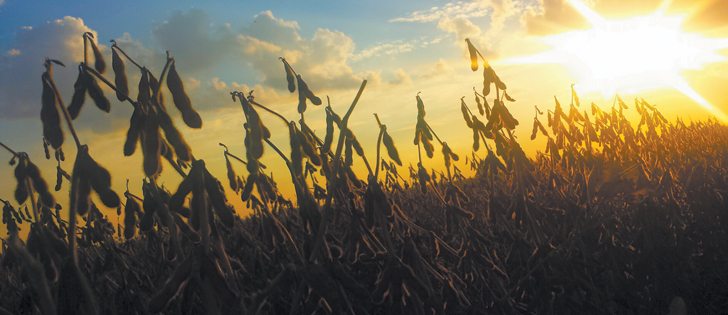The crop is gaining ground in western Manitoba and yields have been increasing, with some reports up to 65 bu. per acre
If current seeding trends continue, something significant might happen in Manitoba during the next five years.
Soybeans could be planted on more acres than canola.
In 2016, Manitoba had almost 1.7 million acres of soybeans and about 3.1 million acres of canola, based on Statistics Canada data.
The gap between the two crops remains huge, but industry watchers think soybeans could reach two million acres soon, possibly in 2017.
Barring a catastrophe, like an early frost or an extremely dry August, soybeans will likely rise above two million acres and could go much higher.
Read Also

Farming Smarter receives financial boost from Alberta government for potato research
Farming Smarter near Lethbridge got a boost to its research equipment, thanks to the Alberta government’s increase in funding for research associations.
“Can we hit three million acres? Yeah, it’s possible,” said Dennis Lange, Manitoba Agriculture industry development specialist for pulse crops.
Lange posed the question, ‘can soybeans hit three million acres,’ during a talk at the Manitoba Agronomists Conference last month.
With 9.5 to 11 million acres of cropland in Manitoba, depending on the definition of cropland, soybeans will have to steal significant acres from other crops to reach three million.
Some of the gains may come from minor crops, but data from the last five years suggests that growers are planting soybeans instead of canola, winter wheat, barley, oats and flax.
To reach three million acres, soybeans would need to oust large acreage crops because displacing 20,000 acres of flax and 25,000 acres of sunflowers won’t do it, Lange said.“It’s those big crops like canola and spring wheat that will really make the difference in seeing more soybean acres.”
In western Manitoba, where soy continues its sprawl, it seems like canola is the crop that’s losing out.
“I think it (the acreage gain) is primarily from canola the last few years,” said Elmer Kaskiw, former Manitoba Agriculture crop production adviser in Shoal Lake.
“In general, we’ve been just inundated with rain, and canola just hasn’t been able to withstand that excess moisture like soybeans can…. The majority of acres, in my opinion, are going to come from canola.”
Canola is still the “go to” crop in western Manitoba but data shows that soybeans have gone from a novelty to a normal crop in a short time.
- In 2011, only about five percent of soybean acres were seeded outside the Red River Valley and central Manitoba
- In 2015, nearly 40 percent of total acres were seeded outside those areas.
As well, yield data indicates that soybeans have been a more reliable crop in Manitoba over the last five years, with yields consistently reaching 30 to 40 and higher.
This year, the average soybean yield in Manitoba could be 42 bu. per acre, which will likely be higher than the average yield for canola.
Reg Dyck, a retired farmer from Starbuck, heard reports of soybean yields of 50 and 60 bu. per acre this fall.
“All the way up to 65 (bu.), let’s say 40 to 65. I don’t think canola is anywhere near that,” he said.
“There’s a benefit to growing soybeans (because) there is less production risk than canola…. With canola, you have the risk of a field (swaths) blowing before harvest. You have flea beetles, you have sclerotinia.”
With record yields, soybean acres are bound to increase in 2017, but Kaskiw wonders how long the soybean craze can last.
“We haven’t seen an early fall frost (for many years),” Kaskiw said.
“That will certainly temper a lot of enthusiasm (for soybeans) once we get one of those.”
Lange agreed. During his presentation he showed photos of soybean fields, in places like Roblin and Dauphin, which were still green in mid-September.
Disease pressure could also put the brakes on expansion. Soybean cyst nematode is often described as the most damaging soybean disease in the United States. The nematode, a microscopic plant-parasitic worm, isn’t in Manitoba but it has been found in North Dakota.
“These things are carried up (via) flood waters so at some point we are going to see it,” Lange said.
There is also the issue of soil fertility. Soybeans are heavy users of in-soil phosphorus but University of Manitoba research shows the crop doesn’t respond to phosphorus added as fertilizer. So managing the crop’s long-term nutrient needs can be tricky.
More agronomic challenges will likely pop up, but for now, soybeans maintain their Cinderella status in Manitoba.
That reputation may fade and soybeans may not reach three million acres, but it’s a safe bet that soybean acres will get close to canola and spring wheat in Manitoba.
“Farmers are going to be the big drivers,” Lange said. “If markets stay steady, definitely the acres will continue to increase.”
Justine Cornelson, a Canola Council of Canada agronomist, said it may be beneficial for soybeans to take acres away from canola.
“Biodiversity is a good thing and we want to be promoting it around and within our cropping system.”
Manitoba acreage change, 2012 to 2016
Increase:
- Soybeans: 736,019 acres
- Feed wheat: 328,196
- Field peas: 116,321
- Grain corn: 65,908
- Prairie spring wheat: 54,957
Decrease:
- Winter wheat: 422,854 acres
- Canola: 332,423
- Barley: 113,198
- Oats: 98,168
- Flax: 53, 317
Source: Manitoba Agriculture
Contact robert.arnason@producer.com


















